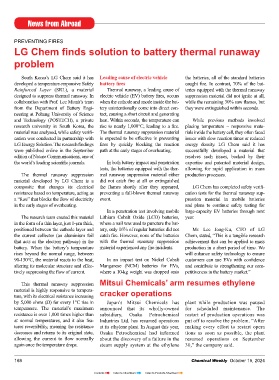Page 168 - CW E-Magazine (15-10-2024)
P. 168
News from Abroad
PREVENTING FIRES
LG Chem finds solution to battery thermal runaway
problem
South Korea’s LG Chem said it has Leading cause of electric vehicle the batteries, all of the standard batteries
developed a temperature-responsive Safety battery fires caught fire. In contrast, 70% of the bat-
Reinforced Layer (SRL), a material Thermal runaway, a leading cause of teries equipped with the thermal runaway
designed to suppress thermal runaway. In electric vehicle (EV) battery fires, occurs suppression material did not ignite at all,
collaboration with Prof. Lee Minah’s team when the cathode and anode inside the bat- while the remaining 30% saw flames, but
from the Department of Battery Engi- tery unintentionally come into direct con- they were extinguished within seconds.
neering at Pohang University of Science tact, causing a short circuit and generating
and Technology (POSTECH), a private heat. Within seconds, the temperature can While previous methods involved
research university in South Korea, the rise to nearly 1,000°C, leading to a fire. placing temperature – responsive mate-
material was analysed, while safety verifi- The thermal runaway suppression material rials inside the battery cell, they often faced
cation was conducted in partnership with is expected to be effective in preventing issues with slow reaction times or reduced
LG Energy Solution. The research findings fires by quickly blocking the reaction energy density. LG Chem said it has
were published online in the September path at the early stages of overheating. successfully developed a material that
edition of Nature Communications, one of resolves such issues, backed by their
the world’s leading scientific journals. In both battery impact and penetration expertise and patented material design,
tests, the batteries equipped with the ther- allowing for rapid application in mass
The thermal runaway suppression mal runaway suppression material either production processes.
material developed by LG Chem is a did not catch fire at all or extinguished
composite that changes its electrical the flames shortly after they appeared, LG Chem has completed safety verifi-
resistance based on temperature, acting as preventing a full-blown thermal runaway cation tests for the thermal runaway sup-
a “fuse” that blocks the flow of electricity event. pression material in mobile batteries
in the early stages of overheating. and plans to continue safety testing for
In a penetration test involving mobile large-capacity EV batteries through next
The research team created this material Lithium Cobalt Oxide (LCO) batteries, year.
in the form of a thin layer, just 1-μm thick, where a nail was used to puncture the bat-
positioned between the cathode layer and tery, only 16% of regular batteries did not Mr. Lee Jong-Ku, CTO of LG
the current collector (an aluminium foil catch fire. However, none of the batteries Chem, stated, “This is a tangible research
that acts as the electron pathway) in the with the thermal runaway suppression achievement that can be applied to mass
battery. When the battery’s temperature material experienced any fire incidents. production in a short period of time. We
rises beyond the normal range, between will enhance safety technology to ensure
90-130°C, the material reacts to the heat, In an impact test on Nickel Cobalt customers can use EVs with confidence
altering its molecular structure and effec- Manganese (NCM) batteries for EVs, and contribute to strengthening our com-
tively suppressing the flow of current. where a 10-kg weight was dropped onto petitiveness in the battery market.”
This thermal runaway suppression Mitsui Chemicals’ arm resumes ethylene
material is highly responsive to tempera- cracker operations
ture, with its electrical resistance increasing
by 5,000 ohms (Ω) for every 1°C rise in Japan’s Mitsui Chemicals has plant while production was paused
temperature. The material’s maximum announced that its wholly-owned for scheduled maintenance. The
resistance is over 1,000 times higher than subsidiary, Osaka Petrochemical restart of production operations was
at normal temperatures, and it also fea- Industries Ltd. has resumed operations put off to resolve the problem. “After
tures reversibility, meaning the resistance at its ethylene plant. In August this year, making every effort to restart opera
decreases and returns to its original state, Osaka Petrochemical had informed tions as soon as possible, the plant
allowing the current to flow normally about the discovery of a failure in the resumed operations on September
again once the temperature drops. steam supply system at the ethylene 30,” the company said.
168 Chemical Weekly October 15, 2024
Contents Index to Advertisers Index to Products Advertised

